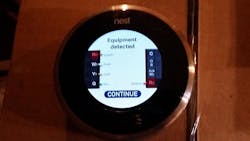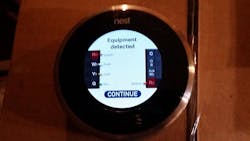I knew things were bad when our sump pump decided to start humming. While it doesn’t get much use, it’s worthwhile to have around because on occasion, there is enough water from heavy rains to cause the pump to run. It was also only the second one used with the house, and we have lived here for decades. Changing it was a pain, but it was a relatively straightforward trip to Home Depot to pop in a replacement.
Of course, things went downhill from there. See, we also have a smaller, less-obvious sump pump for the air conditioner to handle the water generated from cooling the air. The sump pump had an issue because it filled up due to a clog in the tubing used to by the pump to discard the excess water. How I found this out was interesting.
We have a Nest thermostat, and it decided to tell me the wiring was all messed up after the air conditioning shut down (see figure). At first I thought we had a firmware update that messed things up because I had not done any wiring changes. A little more analysis with a volt meter pinpointed the problem.
It turns out that the sump pumps have an overflow detection system that shuts off the power to the HVAC system. And that’s good: It never pays to have the air conditioner generating excess water that winds up on the floor. I’ve had to clean up that kind of mess before. The Nest thermostat takes its power from the HVAC system as well, so when there is no power, it generates a bad wiring error. It would be nice if the Nest would report the sump pump issue, but luckily I figured it out on my own.
This meant another trip to Home Depot for a new pump and tubing. The new pump has LED indicators. I have not figured out how to make the Nest indicate the problem in the future, but at least I know what to look for if it happens again.
Power Loss, Network Loss, More Debugging
The low-tech problems provided an interesting contrast to the high-tech ones. About a week after the Nest incident, we had a brownout and eventually power loss. “Equipment failure” was what the PECO recording told me. What happened after the power came on was another matter.
I have an interesting mix of servers, switches, etc., so my home does not have the usual computer complex; it is more akin to a lab or a small business. Recently I set up a surveillance system using the open source Zoneminder platform, along with a few IP cameras that use Power over Ethernet (PoE). After the power outage, the server recovered but the cameras did not.
I was really hoping the power transients hand not fried the cameras. It turns out it was an error on my part because the network switch with PoE support I was using has a feature common on enterprise solutions, whereby the current active settings are not saved permanently until told to do so. This is useful when making lots of changes that might lock up the network, because a reset will restore the old settings. I forgot this little feature and when turning on the PoE support for the ports with the cameras. The default was no power to those ports, hence the dead cameras.
It turns out that the duration of the power outage was the issue because my UPS systems had kept everything running during past, shorter outages.
Figuring out this problem helped with the related one where my gateway server was not running. If I had a simple standalone gateway box this would usually not be a problem, but in this case I run the server as a virtual machine (VM). Guess what: The server hardware hosting the VM has an option to disable VM support. I remember changing this setting but, like the switch, it requires an extra step to make the change permanent.
Things are running smoothly again....almost. I still have to figure out why the keyboard app on my wife’s smartphone is not working.
Looking for parts? Go to SourceESB.
About the Author
William Wong Blog
Senior Content Director
Bill's latest articles are listed on this author page, William G. Wong.
Bill Wong covers Digital, Embedded, Systems and Software topics at Electronic Design. He writes a number of columns, including Lab Bench and alt.embedded, plus Bill's Workbench hands-on column. Bill is a Georgia Tech alumni with a B.S in Electrical Engineering and a master's degree in computer science for Rutgers, The State University of New Jersey.
He has written a dozen books and was the first Director of PC Labs at PC Magazine. He has worked in the computer and publication industry for almost 40 years and has been with Electronic Design since 2000. He helps run the Mercer Science and Engineering Fair in Mercer County, NJ.
- Check out more articles by Bill Wong on Electronic Design
- Bill Wong on Facebook
- @AltEmbedded on Twitter

